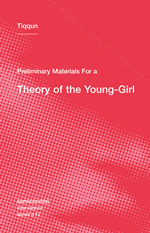Manola Antonioli, Anne Sauvagnargues, Arpenter la maison du monde
DEUX LECTURES DE FÉLIX GUATTARI
René Schérer, Les visions écosophiques de Félix
Anne Querrien, Une lecture des Trois écologies
René Schérer, Les visions écosophiques de Félix
Anne Querrien, Une lecture des Trois écologies
TERRAIN
Monique Selim, Familles chinoises en quête de liberté : une école Steiner à Canton
Tobias Girard, Un exemple d’écosophie des risques industriels
Laurent Bocéno, Fukushinobyl, l’impossible catastrophe
Hideki Kitamaki,, Pour en finir avec les irradiés éclairés
Monique Selim, Familles chinoises en quête de liberté : une école Steiner à Canton
Tobias Girard, Un exemple d’écosophie des risques industriels
Laurent Bocéno, Fukushinobyl, l’impossible catastrophe
Hideki Kitamaki,, Pour en finir avec les irradiés éclairés
POLITIQUE
Fabrice Flipo, La décroissance : une pensée antimoderne ?
Salvatore Panu, Giusi Lumare, Des espaces de résistance en Italie
Fabrice Flipo, La décroissance : une pensée antimoderne ?
Salvatore Panu, Giusi Lumare, Des espaces de résistance en Italie
AGENCEMENT
Manola Antonioli, Cartographier l’inconscient
Anne Querrien, Architecture autogérée, une pratique écosophique de la ville
Manola Antonioli, Cartographier l’inconscient
Anne Querrien, Architecture autogérée, une pratique écosophique de la ville
CLINIQUE ET POESIE
Madatao, Slams
Madatao, Slams
ESTHETIQUE
Roberto Barbanti, Silvia Bordini, Lorraine Verner, Art, paradigme esthétique et écosophie
Pierre Sterckx, Giuseppe Penone : de sève et de bronze
Christian Sorg, Le promeneur de la Sierra
Jean Gabriel Cosculluela, Avec (Christian Sorg)
Nathalie Brevet, Hughes Rochette,, Récits d’expériences
Aliocha Wald Lasowski, Piano nomade et piano écosophique
Roberto Barbanti, Silvia Bordini, Lorraine Verner, Art, paradigme esthétique et écosophie
Pierre Sterckx, Giuseppe Penone : de sève et de bronze
Christian Sorg, Le promeneur de la Sierra
Jean Gabriel Cosculluela, Avec (Christian Sorg)
Nathalie Brevet, Hughes Rochette,, Récits d’expériences
Aliocha Wald Lasowski, Piano nomade et piano écosophique
CONCEPT
Maud Granger Remy, André Gorz et la poésie du monde vécu
Cléber Daniel Lambert Da Silva, La Forêt de cristal de Millevaches : écosophie et cosmopolitiques amérindiennes
Karen Houle, Devenir-plante
Hervé Regnauld, Les concepts de Félix Guattari et Gilles Deleuze et l’espace des géographes
Maud Granger Remy, André Gorz et la poésie du monde vécu
Cléber Daniel Lambert Da Silva, La Forêt de cristal de Millevaches : écosophie et cosmopolitiques amérindiennes
Karen Houle, Devenir-plante
Hervé Regnauld, Les concepts de Félix Guattari et Gilles Deleuze et l’espace des géographes
FICTIONS
Marco Candore, Le dossier 57-C
Stéphane Hubert, De la sexualité chez les androïdes
Nicolas Zurstrassen, Dans les plis, à vie
Marco Candore, Le dossier 57-C
Stéphane Hubert, De la sexualité chez les androïdes
Nicolas Zurstrassen, Dans les plis, à vie
LVE
Manola Antonioli, Benoît Goetz, Théorie des maisons
Christiane Vollaire, Jean-Philippe Cazier, Les collages de Karl Waldmann
Jean-Claude Polack, Rêves d’Akira Kurosawa
Anne Querrien, Hannah Arendt, La condition de l’homme moderne
Read more on Chimères pdf
Manola Antonioli, Benoît Goetz, Théorie des maisons
Christiane Vollaire, Jean-Philippe Cazier, Les collages de Karl Waldmann
Jean-Claude Polack, Rêves d’Akira Kurosawa
Anne Querrien, Hannah Arendt, La condition de l’homme moderne
Read more on Chimères pdf
Présentation du n°76, Écosophie. le 5 avril 2012,
En partenariat avec les éditions érès, la galerie Dufay/Bonnet accueillera
le jeudi 5 avril 2012, à partir de 18 heures
la revue Chimères pour le lancement de son n° 76, Écosophie.
Elle présentera à cette occasion du 5 au 15 avril 2012 une exposition du peintre Christian Sorg
Galerie DUFAY / BONNET
63, rue Daguerre - 75014 Paris
tél : + 33 (0)1 43 20 56 06 / + 33 (0)6 82 66 08 89
Du lundi au vendredi de 11 h à 19 h / le samedi de 15 h à 19 h
et sur rendez-vous.
CHIMÈRES
revue des schizoanalyses










